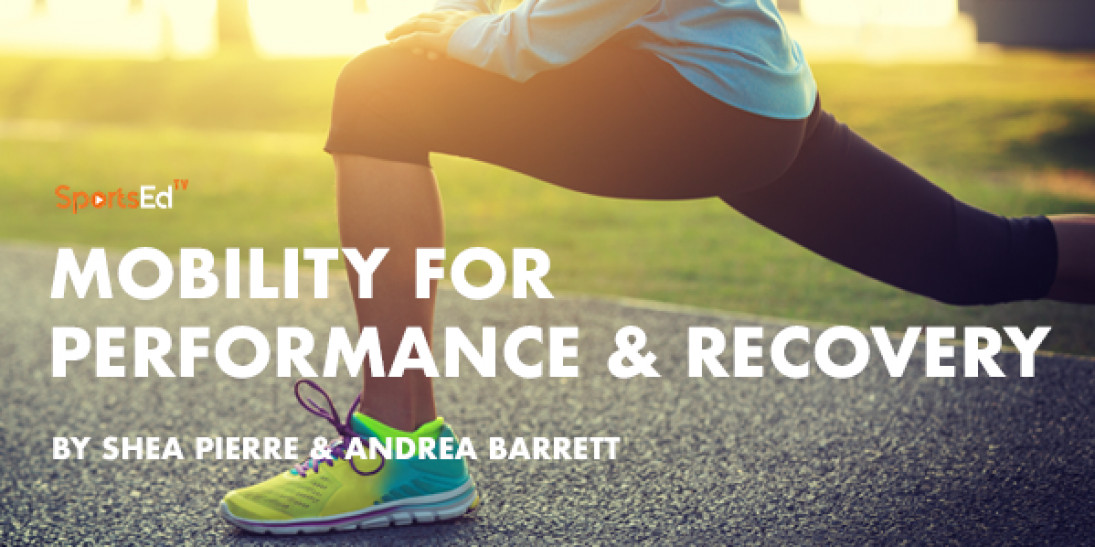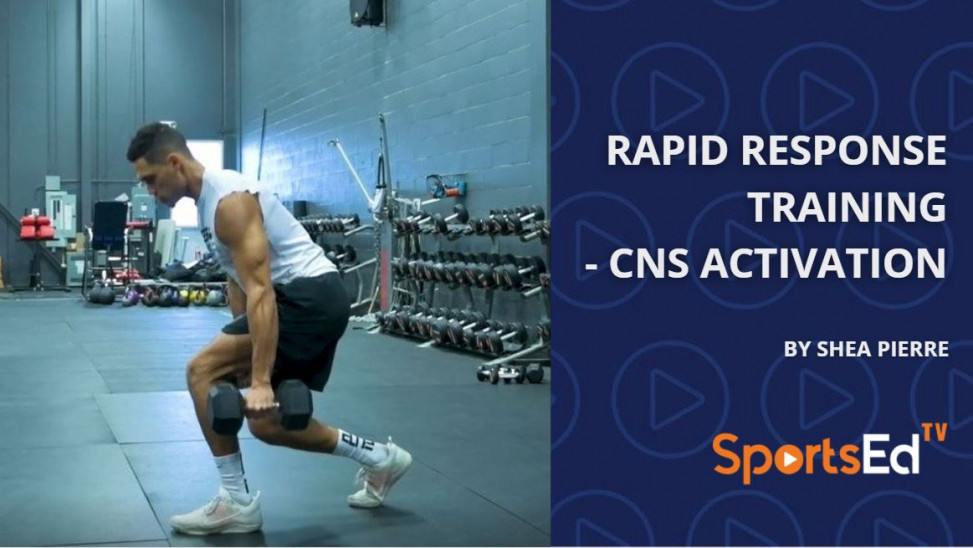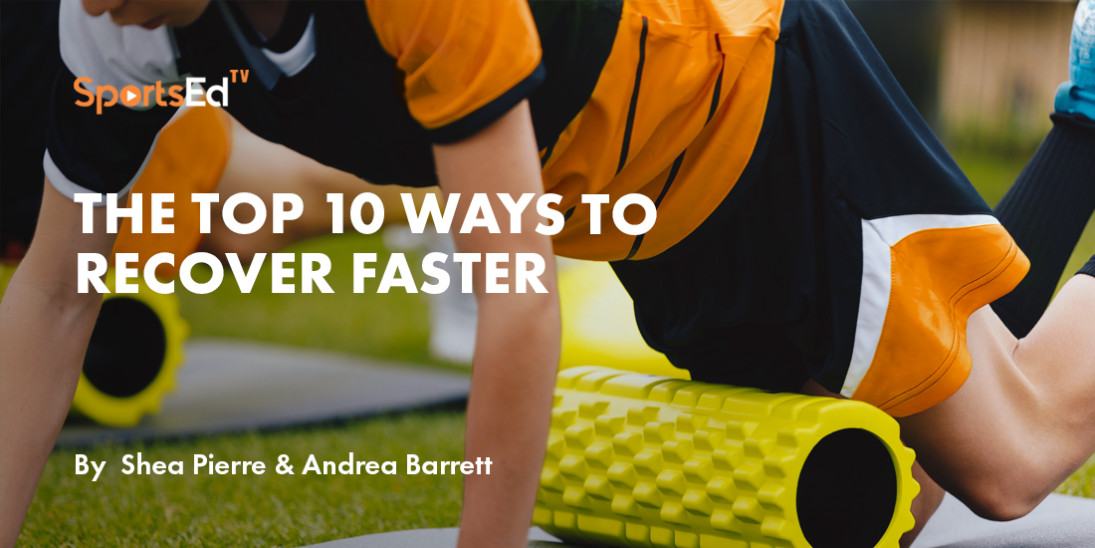Golf, Tennis, Basketball, Volleyball, Soccer, Baseball, Taekwondo, Strength And Conditioning, Swimming
Welcome and thanks for visiting...

The Daily Routine To Improve Mobility, Performance, & Recovery

Mobility and flexibility are two things that generally lack when it comes to fitness. Not only are a lot of athletes unfamiliar with mobility and its importance to athletic performance, but a lot of athletes don’t want to take the time to work on mobility exercises before training or after they finish a training session.
But working on mobility improvements doesn’t have to take hours and hours. As little as 15 minutes a day in the morning, evening, or anytime that suits your schedule is enough to see improvements in physical performance.
What is Mobility?
Believe it or not, flexibility and mobility are not the same things. While they’re often used interchangeably, flexibility is simply a component of mobility.
Mobility is the ability of a joint to move through its entire range of motion fluidly. It’s essentially an all-encompassing term for the various elements that contribute to full range of motion movement, which includes restricted muscle tissue, joints and the joint capsules, motor control, as well as your soft tissues (muscles). Mobility is not just about the muscles, but the joints that allow for movement as well.
Flexibility, on the other hand, is a term that refers to the ability of your soft tissues to stretch when needed. Muscles are similar to a rubber band. If you pull both ends of a rubber band, it will stretch (i.e. it’s flexible). Our muscles are designed with similar elasticity that, when needed for movement, help the muscle to stretch.
Here’s an example to illustrate the difference:
An individual with good mobility may be able to squat below parallel with 175lbs on their back without restrictions in range of motion. A flexible person may be able to break parallel with a bodyweight squat, but once you put weight on their back, they may not have the strength, core strength, balance, or coordination to perform the same movement. Someone with poor mobility may be able to complete a partial rep with x number of pounds on their back but lacks the range of motion necessary to break parallel.
Why is Mobility Important?
When an athlete possesses good mobility, they are able to perform functional movements without limitations on their range of motion. However, an athlete who possesses good flexibility (strength, balance, and coordination) but lacks good mobility, may not be able to perform the same movements.
Long story short — mobility means having strength within your flexibility.
So, in order to have good mobility, you have to have good flexibility.
As an athlete, you probably know that having good mobility and flexibility is key to your performance, but when do you actually use them? Mobility is essential in every aspect of your life. It’s needed for daily movements like getting out of bed, walking up stairs, or picking things up off the ground. The ability to move without joint restriction or pain means that everyday activities can be easily and comfortably completed. But if the body isn’t moving through its natural movement patterns, you’re setting yourself up for injury.
What a lot of athletes don’t think about is that when range of motion is poor, performance suffers. Why? Because if they can’t get into the proper position to execute a lift, they won’t work the muscles they intend to work, which is how compensation and injury happen.
As a culture, regardless of activity level, we spend a lot of time in poor, static positions — whether it be sitting at a desk all day or watching TV for an extended period of time — which results in tight muscles that decrease ROM and limit activation of certain muscle groups. For example, sitting for too long causes the hip flexors to shorten and tighten, deactivation of the glutes and hamstrings, the shoulders to round forward, and other muscles to lose function due to extended periods of time holding a static position.
When you head into a workout, training session, or even a game with limited range of motion, muscle compensation starts to happen; secondary muscles, that are normally smaller and weaker, start to take over for weak or inhibited primary muscles, which increases the amount of torque they experience and leaves you with a recipe for disaster (i.e. pain, injury, etc.). To make matters worse, if you’re looking to build muscle, going into a lift with decreased ROM means you’re not even working the muscles you want to, therefore you’re not building the muscle you’re working towards.
The thing with mobility is that the body will compensate in any way it can to prevent injury from happening, so most athletes don’t know they have poor mobility until it’s too late. The body will put up with poor mobility and improper movement patterns for only a finite time — until it’s had enough.
To give you a run down of why you need good mobility, it helps with a few things:
1. Decreases risk of injury
Any level of restriction to freely moving joints increases the chance of injury. When antagonistic muscles take over for agonists (prime movers), there’s more force placed on muscles that are smaller and weaker than their primary counterparts.
A lot of injuries happen because the body cannot handle the demands that are placed on it. The goal of mobility training is to build a body that can handle the requirements and stress of a specific sport and its movements. Adding in mobility work also helps to locate points of weakness, which then allows you to focus attention on those points for improvement.
We all know that injury can happen in an instant and severely halts performance. No athlete wants to be on the sidelines because they neglected something that they know they should be doing, so implementing some sort of mobility work prior to or after every training session should be a must.
2. Keeps joints strong and healthy
Joint mobility and stability are the cornerstones of functional movement and resistance training. The idea behind developing joint mobility and stability is to develop postural stability throughout the kinetic chain without compromising mobility at any point in the chain.
Joint mobility is the degree to which an articulation — the point where two bones meet — can move before being restricted by surrounding tissues (ligaments, tendons, muscles etc.). This is also known as the range of uninhibited movement around a joint. Joint Stability, on the other hand, refers to the ability to maintain or control the movement or position of a joint and is achieved by coordinating the actions of surrounding tissues and the neuromuscular system. Both are completely necessary for good mobility and strength.
Consistently doing mobility work helps to keep joints limber and with proper range of motion to ensure they’re not impeding on movement.
3. Improves strength and performance
Limited ROM translates directly to limited muscle growth. Having optimal mobility and movement allows for better positions when doing lifts, which ultimately allows for better efficiency in your lifts and movements. At the end of the day, this means that you’re hitting the muscle groups that you’re trying to hit and therefore developing maximal muscle growth. Additionally, strengthening the stabilizing muscles is important for keeping joints strong and preventing injury or damage during movements.
A training regimen that lacks mobility work means that movements can become hindered by poor range of motion, pain, and muscle compensation patterns. Implementing mobility work as part of your recovery routine is important to allow the body to rest and repair, as overtraining and lack of proper recovery leaves you more susceptible to injuries.
Chances are good that most athletes have some sort of movement restriction as a result of daily lifestyle habits, which will hinder movements during training in some capacity. However, when you’re able to understand any movement restrictions you may have and how to go about correcting and improving them, you can focus on the mobility and motor control you have attained. This is done by following specific movements and drills that target certain muscle groups to correct movement patterns. Now, it’s important to remember that mobility and strength programs go hand-in-hand. Mobility work can become part of a workout-specific warmup to avoid forms of compensation and keep movements at a quality level. When incorporating mobility, always remember that the work should be specific to the needs of the athlete, so regular re-assessment is crucial.
Doing this means that you’ll get the most from your strength training routine and be able to hit new numbers rather than sitting on the sidelines with an injury.
Why Mobility is Necessary for Recovery
Training daily is hard on the body — there’s no two ways around it. And while recovery methods like saunas, nutrition, and sleep are all critical to help the body rest and repair, adding in mobility work as well can give you a one-up on your recovery.
Spending just 10-20 minutes daily on stretching and foam rolling can help increase the responsiveness of muscles and reduce the amount of soreness you experience. This light activity and stretching will warm up the soft tissues of the body in preparation for more intense activity. After your workout is complete, both core body temperature as well as blood flow are elevated, which means it’s the best time towork on mobility training as muscles, tendons, and ligaments respond best at elevated temperatures to these sorts of exercises.
Foam rolling is a great way to improve both mobility and recovery
As for improving recovery, foam rolling, stretching, and strengthening — the three aspects of mobility — work together to speed up muscle recovery. Releasing trigger points helps to re-establish proper movement patterns, gain back pain free movement, and essentially enhance athletic performance. Stretching alone is not always enough to release tight muscles, which is where SMR (foam rolling) comes into play. Foam rolling helps to break up these muscle knots, resume normal blood flow, and normal muscle function.
The end all for mobility work, and any corrective or recovery technique for that matter, is to get you back to the point of normal functioning as if nothing happening in the first place.
Testing Your Mobility
If you’re just starting out with mobility, following the Functional Movement System (FMS) tests are a good way to determine your baseline. The goal of the FMS assessment is to capture fundamental movements, motor control within movement patterns, and competence of basic movements. In doing so, coaches can determine the greatest areas of movement deficiency, demonstrate limitations or asymmetries, and form a program to correct underlying issues. The test is made up of 7 specific movements that require balance of mobility and stability and provide information on performance of basic mobility and stability movements by placing individuals in positions where weaknesses, imbalances, asymmetries and limitations are noticeable.
- Deep squat: The deep squat position demonstrates fully coordinated extremity mobility and core stability, with the hips and shoulders functioning in symmetrical positions. Extremity mobility, postural control, pelvic and core stability are all well represented in a deep squat movement pattern. It challenges total body mechanics and neuromuscular control when performed properly. The deep squat tests bilateral, symmetrical, functional mobility and stability of the hips, knees and ankles.
- Hurdle step: This pattern is an integral part of movement and acceleration. While it’s not a step we do everyday, it exposes compensations and asymmetry in stepping patterns. It challenges the body’s step and stride mechanics while testing stability and control in a single stance. To conduct this movement correctly requires proper coordination and stability between the hips and pelvic and core stability and alignment. The hurdle step assesses bilateral mobility and stability of the hips, knees and ankles, as well as stability and control of the pelvis and core.
- Inline lunge: This movement pattern is part of all deceleration movements and directional changes that occur in activity and sport. The inline lunge places the body in a position that focuses on the stresses as they would present during rotation, deceleration, and lateral movements. The narrow base of a lunge requires appropriate starting stability and continued dynamic control of the pelvis and core within an asymmetrical hip position. The natural counterbalance of the upper and lower extremities demands spinal stabilization as well. The inline lunge pattern tests hip, knee, ankle and foot mobility and stability.
- Shoulder mobility: This movement pattern demonstrates the complementary rhythm of the scapular-thoracic region, thoracic spine, and rib cage during reciprocal upper extremity shoulder movements.
- Active straight leg raise: The active straight leg raise identifies the active mobility of the flexed hip, as well as initial and continuous core stability within the pattern and hip extension of the alternate hip. It assesses the ability to separate the lower extremities in an unloaded position.
- Trunk stability push-up: This movement is a single-rep version of the floor-based pushup. It uses basic observation to assess reflex core stabilization through the initiation of movement with the upper extremities in a push-up position without allowing movement of the spine or hips.
- Rotary stability: The rotary stability pattern observes multi-plane pelvis, core, and shoulder girdle stability during a combined upper and lower extremity movement. The movement requires proper neuromuscular coordination and energy transfer through the torso. The goal is to demonstrate reflex stabilization and weight shifting in the transverse plane, as well as coordination of mobility and stability during climbing patterns.
Here’s How to Improve It
There are three options when it comes to improving mobility. For the most successful results, combining all three is recommended.
- Self-myofascial release (foam rolling) — While foam rolling can be pretty uncomfortable, and downright painful, at times, SMR helps to break up adhesions and scar tissue within muscles as well as improve blood circulation.
- Stretching — Focusing on dynamic, rather than static, stretches is a great way to get the body warmed up for action. This includes movement-based stretching as well as sports-specific drills. The focus should be placed on the wrists, ankles, hips, and shoulders. Yoga is also great to incorporate into your routine, as the connective tissues you want to keep mobile are closely related to the muscles you want to keep flexible.
- Strengthening — Strengthening, in this case, focuses on adding strength to the muscles that work to stabilize joints.
Check out the following four sequences for you to work into your daily routine to increase mobility.
1. The Biotechnical Retune
2. The Retune System
3. Night Routine
4. Morning Routine
Mobility for the Foot and Ankle
Good mobility of the foot and ankle is non-negotiable for an athlete. The foot is the lone contact point with the ground and the place where ground forces and load impacts are introduced to the rest of the body. In order for an athlete to reap any benefits and rewards from their training, the foot and ankle must be functioning optimally. If dysfunction or compensatory patterns are present, they must be addressed first to prevent more serious issues down the road that could sideline your career.
1. Roll your feet — The arches of the foot act as both a shock absorber and a weight bearer. Using a small rolling object or a lacrosse ball is one of the best ways to release the muscles on the bottom of the foot. Roll in all directions and/or press and apply weight in various spots, sitting or standing depending on your tolerance. Aim for 1-3 minutes on each foot.
Lacrosse balls like these are great for rolling out the arch of your foot. 1-3 minutes per foot, rolling in all directions, across different spots on your foot
2. Toes tucked ankle sit — With the knees and feet together, curl the toes under like a sprinter in the blocks exercise. Tuck the toes and then sit back on your heels to open the toes and open the plantar fascia. Hold this position for 90 seconds.
3. “Laces down” ankle sit — Then put the “laces down” and sit down on a hyper plantar flexed ankle to open the cuneiform, cuboid, and navicular joints of the top of the foot. These three joints have a direct neurological connection to the psoas, hamstrings, and muscles of the hip. Hold this position for 90 seconds.
Mobility for the Hips and Glutes
More often than not, glute issues manifest from an issue elsewhere. If you’re experiencing tight, weak or painful glutes, there is likely another smaller muscle or muscles somewhere close that are actually the root of the problem. For example, tight hip flexor muscles will cause inhibition of the glute muscles and will result in weakness.
1. Psoas and hip flexor release — There are many stretches available to open up the glutes and hips. Cossack squats into a lunge sun salutation are fantastic for unlocking the hips and forcing them into submission. Similarly, quad stretches and hurdler stretches are also great. If you’re looking to strengthen the hips and glutes, try doing kettlebell swings. Other options include:
-
-
- Lying hip rotations
- Piriformis stretch
- Kneeling lunge
- Squatting internal rotations
- Pigeon stretch
-
2. Glute bridge with band — Place a mini band around your calves or just above the knees. Lie on your back and lift your hips into a bridge position. Keeping tension on the band, tap your hips down to the floor and then lift back up while maintaining a straight spine. Perform 10-15 repetitions.
Mobility for the Thoracic Spine
The thoracic spine is essentially the gateway to the upper body. As you can guess by now, poor lifestyle choices lead to posture that feeds thoracic spine dysfunction. The accumulation of training session after training session can also cause the spine to become locked and immobile, which in the long run can cause a myriad of issues with the shoulders, upper back, and lower back.
1. Thoracic bridge — A thoracic bridge is a movement pattern that incorporates full body integration to mobilize the thoracic spine. It not only gets the upper spine moving, but it forces control and stabilization of the hips and shoulders as well.
2. Diagonal sit with a twist — Sit with one leg in front of the other keeping the ankle, knee, and hip of the back leg in line. Keep the front leg perpendicular to your body and align the elbow below the shoulder. Rotate the top shoulder towards the floor while you extend the top shoulder and contract the latissimus and glute as you exhale. Repeat 15 times, controlling the movement each way.





